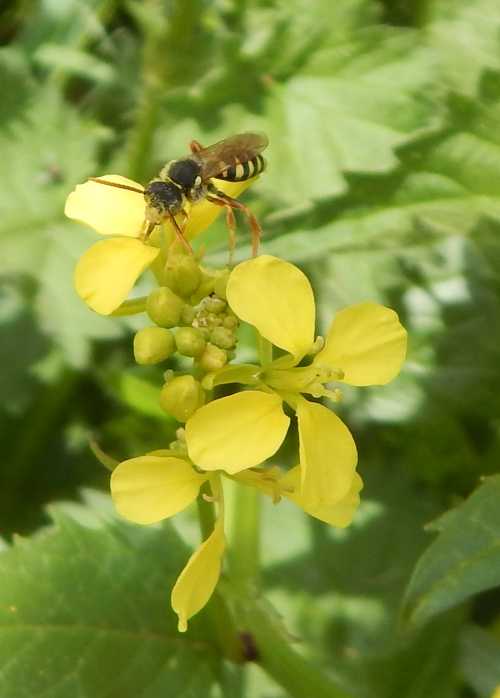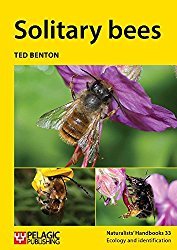Sphecodes - Blood Bees
Sphecodes - blood bees, are small to medium-sized bees measuring from 4.5mm to about 15mm long1.
They are included in the Halictidae bee family, and more than 300 species have been described worldwide1. They are found on all continents with the exception of Australia1.
About Sphecodes - Blood Bees
Blood bees are slender, with a sparse covering of hair. They usually have a red or red and black abdomen.
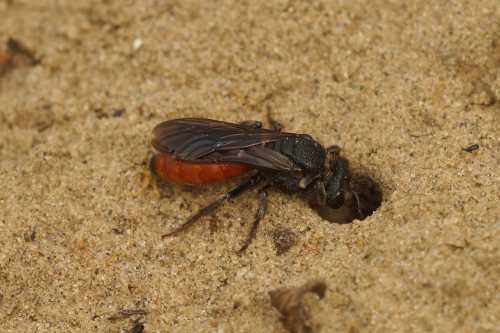 Sphecodes albilabris - Giant Blood Bee
Sphecodes albilabris - Giant Blood Bee
Authors of The Bees In Your Backyard, Wilson & Messinger Carril2 note that Sphecodes is Greek for 'wasp like', and indeed, their general appearance is a little wasp-like (though arguably less so than bees in the genus Nomada).
However, in my view, Sphecodes could perhaps more easily be confused with the Red-girdled Mining Bee (Andrena labiata) or the red form of Andrena hattorfiana (Large Scabious Mining Bee).
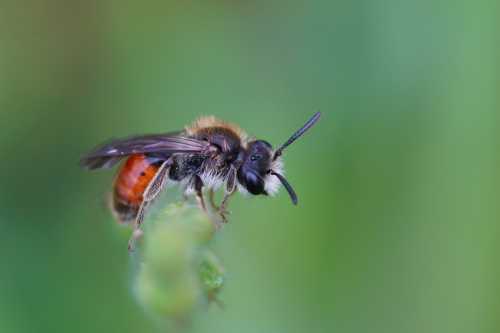 Red-girdled Mining Bee (Andrena labiata) - male
Red-girdled Mining Bee (Andrena labiata) - maleSphecodes - Blood Bees - Are Cleptoparasites
Sphecodes are cleptoparasites (i.e. "cuckoo" species), and as such, they do not gather pollen (unlike the Andrena species mentioned above).
They therefore lack the long scopa (pollen hairs) or pollen baskets for carrying pollen on the hind legs, as seen in non-parasitic species.
Instead, blood bees rely on a ground-nesting target host (usually species from the Andrena, Halictus, Lassioglossum or Colletes genera) to provide food and shelter for their offspring2.
However, according to species observations, females may exhibit a range of behaviours at the nest of a target host.
Sick et al (1994) observed that a Sphecodes female entering the nest of a Lassioglossum malachurum approached head-on, presumably to use her jaws (mandibles) to chew an opening in a closed egg cell, and destroy the eggs of the host3,4.
She was then observed to back out of the host nest, then re-enter, this time abdomen-first, probably to lay her own egg inside the opened cell. She remained inside the nest cell until the following day, whereupon she resealed the entrance to the nest, and left.
More recently, Bogusch et al found that the behaviours of Sphecodes species varied. They were seen to enter the host nest sometimes when the host was absent, but at other times whilst the host was present3,4,5.
Furthermore, if present, the host has been observed that she may engage in defensive behaviours (blocking the nest entrance, or chasing the cleptoparasite away), however, in some species, a target host may allow entry of Sphecodes into the nest without resistance6.
Conflict between the host and cleptoparasite has been observed (fights on the ground, involving stings), with the Sphecodes female killing the host or vice versa. If the blood bee species is successful, she will remain at the nest to lay eggs in adequately provisioned cells5,6.
Occasions when the host species targeted by the blood bee were eusocial rather than solitary, have been noted, however, the cleptoparasite's strategy for entering the nest remained the same, as long as the nesting cycle of a social host was in the solitary stage (i.e., a single host female at the nest)5.
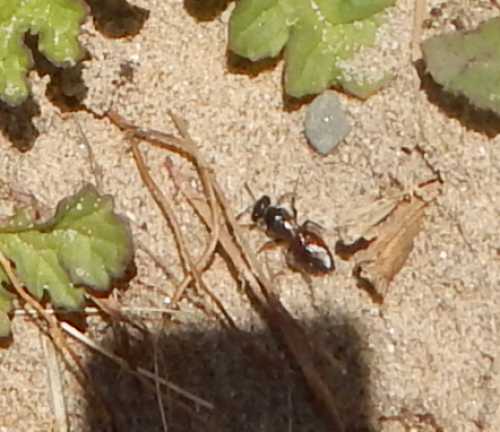 This Sphecodes albilabris (Giant Blood Bee) was found in a location close to the nests of a target host, Colletes cunicularius - the Early Mining Bee.
This Sphecodes albilabris (Giant Blood Bee) was found in a location close to the nests of a target host, Colletes cunicularius - the Early Mining Bee.A single Sphecodes species may demonstrate some flexibility in target host selected4, with some species such as Sphecodes ephippius targetting as many as 17 different species6.
The behaviour of Sphecodes is in contrast to other cleptoparasites, such as the sharp-tail bees (Coelioxys), where the large-mandibled larva of the cleptoparasite kills the competing host offspring, rather than the adult mother.
Foraging Behaviours
Sphecodes demonstrate polylectic foraging behaviour (i.e. they visit flowers from a wide range of plant families) from which they feed on nectar1.
They may be seen on dandelions and other composites, Fennel, mayweeds, cinquefoils, Rock Samphire, knapweeds, fleabane (Erigeron), roses, brambles, umbellifers such as Wild Carrot, buttercups, thistles, Wood Spurge, and heathers7.
References
1. ÖZBEK, HİKMET; BOGUSCH, PETR; and STRAKA, JAKUB (2015) "A contribution to the kleptoparasitic bees of Turkey: Part I.,the genus Sphecodes Latreille (Hymenoptera: Halictidae)," Turkish Journal of Zoology: Vol. 39: No. 6, Article 13. https://doi.org/10.3906/zoo-1501-43
2. Wilson & Messinger-Carril; The Bees In Your Backyard, Princeton University Press 2016.
4. Ted Benton, Solitary Bees, Pelagic Publishing 2017.
5. Sick, M. et al. “Host-parasite relationships in six species of Sphecodes bees and their halictid hosts: Nest intrusion, intranidal behavior, and Dufour's gland volatiles (Hymenoptera: Halictidae).” Journal of Insect Behavior 7 (2005): 101-117.
6. Bogusch, Petr et al. “Generalist cuckoo bees (Hymenoptera: Apoidea: Sphecodes) are species-specialist at the individual level.” Behavioral Ecology and Sociobiology 60 (2006): 422-429.
7.Field Guide to Bees Of Great Britain And Ireland by Steven Falk, Bloomsbury 2015.
